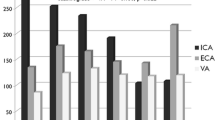Abstract
Purpose
The descriptions of collateral circulation in moyamoya have so far been a mixture of topography-based and vessels’ source-based analyses. We aimed to investigate the anatomy and systematize the vascular anastomotic networks in pediatric moyamoya disease.
Methods
From a series of 25 consecutive complete angiographic studies of newly diagnosed children with moyamoya, 14 children had moyamoya disease and 11 were diagnosed with moyamoya syndrome, i.e., moyamoya angiopathy with some additional concomitant systemic disease. We retrospectively analyzed the arterial branches supplying the moyamoya anastomotic networks, their origin, course, location, and connections with the recipient vessels.
Results
We describe four types of anastomotic networks in children with moyamoya disease, two superficial-meningeal and two deep-parenchymal. As superficial-meningeal, we defined the leptomeningeal and the durocortical networks. Apart from the previously described leptomeningeal network observed in the convexial watershed zones, we report on the basal temporo-orbitofrontal leptomeningeal network. The second superficial-meningeal network is the durocortical network, which can be basal or calvarian in location. We define as deep-parenchymal networks the nonpreviously described subependymal network and the inner striatal and inner thalamic networks. The subependymal network is fed by the intraventricular branches of the choroidal system and diencephalic perforators, which at the level of the periventricular subependymal zone, anastomose with medullary—cortical arteries as well as with striatal arteries. The inner striatal and thalamic networks are constituted by intrastriatal connections among striatal arteries and intrathalamic connections among thalamic arteries when the disease compromises the origin of one or more sources of their supply.
Conclusion
The previously inexplicitly described “moyamoya abnormal network” in pediatric moyamoya disease can be described as a composition of four anastomotic networks with distinct angioarchitecture. A better understanding of the collateralization in moyamoya may help in defining a new staging system of the disease with clinical relevance.




Similar content being viewed by others
References
Suzuki J, Kodama N (1983) Moyamoya disease—a review. Stroke J Cereb Circ 14(1):104–109
Takanashi J (2011) Moyamoya disease in children. Brain Dev 33(3):229–234. doi:10.1016/j.braindev.2010.09.003
Takebayashi S, Matsuo K, Kaneko M (1984) Ultrastructural studies of cerebral arteries and collateral vessels in moyamoya disease. Stroke J Cereb Circ 15(4):728–732
Scott RM, Smith JL, Robertson RL, Madsen JR, Soriano SG, Rockoff MA (2004) Long-term outcome in children with moyamoya syndrome after cranial revascularization by pial synangiosis. J Neurosurg 100(2 Suppl Pediatrics):142–149. doi:10.3171/ped.2004.100.2.0142
Smith ER (2012) Moyamoya arteriopathy. Curr Treat Options Neurol 14(6):549–556. doi:10.1007/s11940-012-0195-4
Currie S, Raghavan A, Batty R, Connolly DJ, Griffiths PD (2011) Childhood moyamoya disease and moyamoya syndrome: a pictorial review. Pediatr Neurol 44(6):401–413. doi:10.1016/j.pediatrneurol.2011.02.007
Kassner A, Zhu XP, Li KL, Jackson A (2003) Neoangiogenesis in association with moyamoya syndrome shown by estimation of relative recirculation based on dynamic contrast-enhanced MR images. AJNR Am J Neuroradiol 24(5):810–818
Matsushima Y, Inaba Y (1986) The specificity of the collaterals to the brain through the study and surgical treatment of moyamoya disease. Stroke J Cereb Circ 17(1):117–122
Baltsavias GVA, Filipce V, Khan N (2014) Selective and superselective angiography of pediatric Moyamoya disease angioarchitecture; anterior circulation. Interv Neuroradiol 20(4):391–402. doi:10.15274/NRJ-2014-10050
Baltsavias G, Khan N, Filipce V, Valavanis A (2014) Selective and superselective angiography of pediatric moyamoya disease angioarchitecture in the posterior circulation. Interv Neuroradiol. doi:10.15274/INR-2014-10041
Lasjaunias P, Berenstein A, Ter Brugge KG (2001) Surgical neuroangiography, vol 1. 2nd edn. Springer
Baker HJ (1972) The angiographic delineation of sellar and parasellar masses. Radiology 104:67–78
Marinković SV, Milisavljević MM, Marinković ZD (1989) Microanatomy and possible clinical significance of anastomoses among hypothalamic arteries. Stroke J Cereb Circ 20(10):1341–1352
Hunter J (1837) The works of John Hunter FRS, with notes, vol III. London
Shellshear J (1920) The basal arteries of the forebrain and their functional significance. J Anat 55(Pt 1):27–35
Van den Bergh R (1969) Centrifugal elements in the vascular pattern of the deep intracerebral blood supply. Angiology 20(2):88–94
Plets C, De Reuck J, Vander Eecken H, Van den Bergh R (1970) The vascularization of the human thalamus. Acta Neurol Belg 70(6):687–770
De Reuck J (1971) The human periventricular arterial blood supply and the anatomy of cerebral infarctions. Eur Neurol 5(6):321–334
Handa J, Handa H (1972) Progressive cerebral arterial occlusive disease: analysis of 27 cases. Neuroradiology 3:119–133
Kaplan HA, Ford DH (1966) The brain vascular system. Elsevier, Amsterdam
Yamamoto T, Kagami T, Tamagiwa A, Kawarada Y (1966) Physiologic aspects of vascular network at brain base of newborn and its correlation with cerebral juxtabasal telangiectasia. Nippon Acta Neuroradiologica 7:12–15
Kuban KCGF (1985) Human telencephalic angiogenesis. Ann Neurol 17(6):539–548
Gilles F (2001) Telencephalic angiogenesis: a review. Dev Med Child Neurol Suppl 86:3–5
Moody DMBM, Challa VR (1990) Features of the cerebral vascular pattern that predict vulnerability to perfusion or oxygenation deficiency: an anatomic study. AJNR Am J Neuroradiol 11(3):431–439
Nelson MD Jr, G-GI GFH (1991) Dyke Award. The search for human telencephalic ventriculofugal arteries. AJNR Am J Neuroradiol 12(2):215–222
Mayer PLKE (1991) The controversy of the periventricular white matter circulation: a review of the anatomic literature. AJNR Am J Neuroradiol 12(2):223–228
Van den Bergh R (1992) The ventriculofugal arteries. AJNR Am J Neuroradiol 13(1):413–415
Nakamura YOT, Hashimoto T (1994) Vascular architecture in white matter of neonates: its relationship to periventricular leukomalacia. J Neuropathol Exp Neurol 53(6):582–589
Takahashi S (2010) Neurovascular imaging. Springer, London
Saito R KT, Sonoda Y, Kanamori M, Mugikura S, Takahashi S, Tominaga T. (2013) Infarction of the lateral posterior choroidal artery territory after manipulation of the choroid plexus at the atrium: causal association with subependymal artery injury. J Neurosurg 29
Marinković S, Gibo H, Filipović B, Dulejić V, Piscević I (2005) Microanatomy of the subependymal arteries of the lateral ventricle. Surg Neurol 63(5):451–458
Yakovlev P (1968) Telencephalon “impar”, “semipar” and “totopar”. (Morphogenetic, tectogenetic and architectonic definitions). Int J Neurol 6(3–4):245–265
Author information
Authors and Affiliations
Corresponding author
Additional information
No Institutional Review Board vote for this retrospective study was necessary.
Rights and permissions
About this article
Cite this article
Baltsavias, G., Khan, N. & Valavanis, A. The collateral circulation in pediatric moyamoya disease. Childs Nerv Syst 31, 389–398 (2015). https://doi.org/10.1007/s00381-014-2582-5
Received:
Accepted:
Published:
Issue Date:
DOI: https://doi.org/10.1007/s00381-014-2582-5




